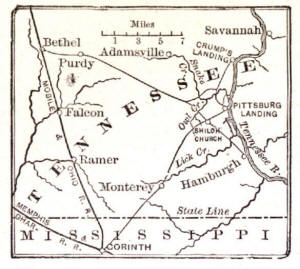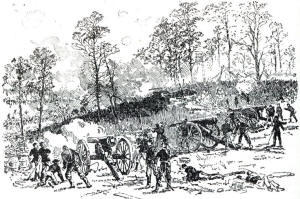|
This Site:
Civil War
Civil War Overview
Civil War 1861
Civil War 1862
Civil War 1863
Civil War 1864
Civil War 1865
Civil War Battles
Confederate Generals
Union Generals
Confederate History
Robert E. Lee
Civil War Medicine
Lincoln Assassination
Slavery
Site Search
Civil War Links
Civil War Art
Revolutionary War
Mexican War
Republic of Texas
Indians
Winslow Homer
Thomas Nast
Mathew Brady
Western Art
Civil War Gifts
Robert E. Lee Portrait
|
Shiloh (Pittsburg Landing), BATTLE OF. After the capture of
Fort Donelson in 1862.
General Grant prepared to push towards
Corinth, an important position at the intersection of the Charleston and
Memphis,
Mobile and Ohio railways. Possession of that point would give the National troops control of the great railway communications between the Mississippi and the East, and the border slave-labor States and the Gulf of Mexico. Passing up the Tennessee River, the main body of Grant's troops were encamped, at the beginning of April, between Pittsburgh Landing, on that stream, and Shiloh Meeting
House, in the forest, 2 miles from the river bank. | 
MAP OF THE SHILOH CAMPAIGN |
General Beauregard, under the supreme command of
General Albert Sidney Johnston, was straining every nerve to resist this movement. He confronted the Nationals near Shiloh Meeting house, where he was assisted by Generals
Polk,
Hardee,
Bragg, and
Breckinridge. With these expert leaders the confederates had come up from
Corinth in a heavy rainstorm, in separate columns, and so stealthily that they were within 4 miles of the National camp before they were discovered by Grant's sentinels. There they halted (April 5) to await the arrival of Van Dorn and Price, who were approaching
Memphis with a large force from Central Arkansas.
The Confederate army now numbered about 40,000 men. Grant had made his headquarters at
Savannah, on the Tennessee, and he there continued until the first week in April, having very little apprehension of an attack from the Confederates.
General Sherman's division was just behind Shiloh Meeting-house.
General Prentiss was encamped across the road to
Corinth, with
General McClernand's division behind his right. Their three divisions formed the advanced line. In the rear, near the river, lay General Hurlbut's division and that of General Smith, under the command of
Gen. W. H. L. Wallace, of Illinois. General Stuart's brigade, of Sherman's division, lay on the Hamburg road, and the division of
Gen. Lew Wallace was at Crump's Landing, below Pittsburgh Landing. Such was the disposition of the National army on Sun-day morning, April 6. |
Buell had been marching very tardily across Tennessee in the direction of
Corinth. Hearing of his approach. Johnston resolved not to wait for Van Dorn and Price, but to strike the Nationals before
Buell's arrival. At a council of war (April 5) that made this decision,
Beauregard said: "Gentlemen, we sleep in the enemy's camp to-morrow night.'' | 
THE BATTLE OF SHILOH | Almost the first intimation of the near presence of the Confederates was the wild cry of pickets flying into camp, and the sharp attack upon Sherman's troops by
Hardee's division, before daylight had fairly appeared. It was a surprise. Screaming shells dashed through the forest and bullets whistled among the tents. The Confederates had rushed into the
camp, driving half-dressed, half-armed soldiers before them, dealing death and terror in every direction.
Prentiss's division was next attacked; his column was shattered, and he, with a large portion of his followers, were made prisoners, his camp being captured by the Confederates. The struggle soon became general, and for ten hours the battle raged with varying fortune on both sides. Gen. W. H. L. Wallace. of the Nationals, and
General A. S. Johnston, of the Confederates, had been killed. On both sides the slaughter was severe, and the National army was pushed back to the river, then brimful with a spring flood. The day was
a devastating loss for the Union troops. All the Union camps were occupied by the Confederates but one—that of
General Wallace, of which General MacArthur was now in command. In the rear of this the smitten army had gathered at twilight, in a space not more than 400 acres in extent, on the verge of the river. They could be hushed hack no farther.
Beauregard telegraphed to Richmond a shout of victory. The Nationals were in a most perilous position. A single vigorous blow then given would have justified this shout.
Beauregard gave feeble ones that were parried by two gunboats on the river, which had just arrived, and by a hastily formed battery on the shore. That evening the van of
Buell's army also appeared on the opposite side of the river; and at midnight,
Gen. Lew. Wallace, who had been detained by misinformation, arrived. In the morning twilight (April 7) Wallace's troops opened the battle anew on the Confederate left; where
Beauregard commanded in person. Others soon joined in the battle, and it became general all along the line. The Confederates fought gallantly, but were speedily pushed hack by a superior force. When they perceived that all was lost, they fled in the direction of
Corinth, in a blinding storm of rain and sleet, and halted on the heights of Monterey, covered in their retreat by a rear guard of 12,000 men, led by General
Breckinridge. The Confederates had lost over 10,000 men in the engagement and retreat. Fully 3,000 died during the flight to the heights of Monterey. The National loss in killed, wounded, and prisoners was about 15,000. The slain on the battlefield were buried; the dead horses were burned. The hospital vessels sent down the Tennessee were crowded with the sick and wounded.
Beauregard valliant army fell back to
Corinth, and Grant was about to pursue and capture it, when
General Halleck, his superior in rank, came up and took the chief command, and caused the army to loiter until the Confederates, recuperated, were ready for another battle. |
|

